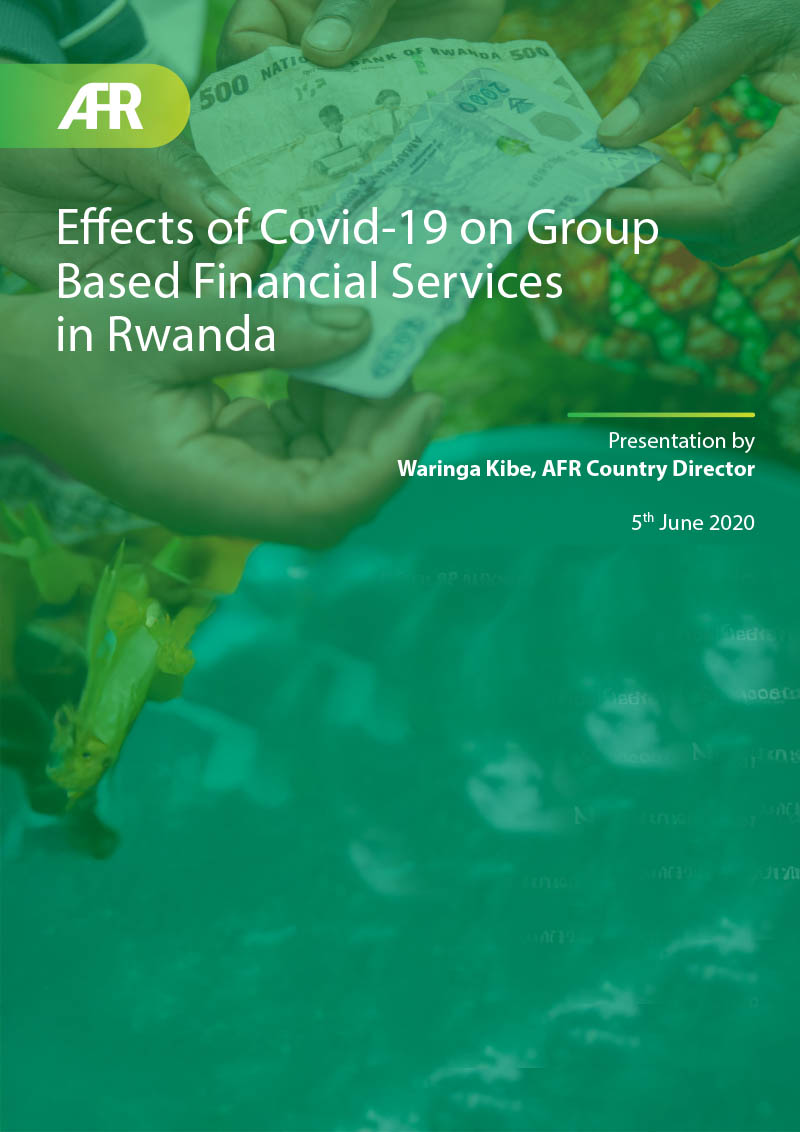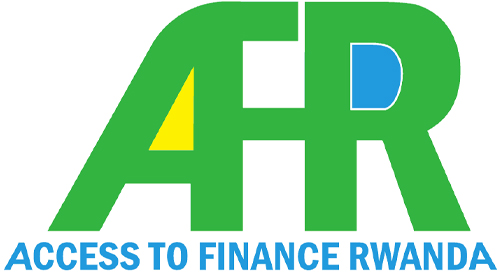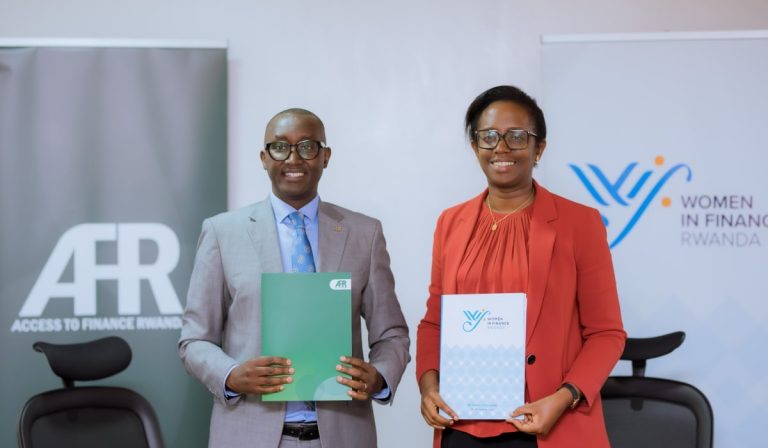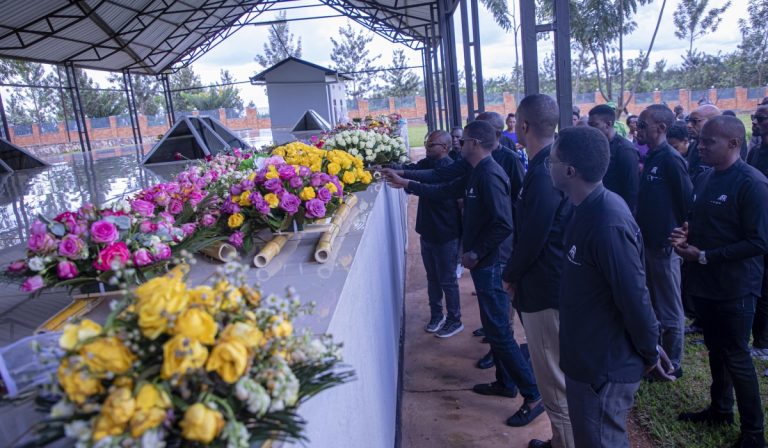
Takeaways from the April 2020 Rwanda Savings Group Practitioner’s Forum
On the 3rd of April 2020 the Savings Groups Practitioners Forum in Rwanda met through a webinar hosted by Access to Finance Rwanda (AFR) to discuss some of the effects they and their members or clients were facing as a result of the spread of Covid-19.
The Rwanda Savings Group Practitioner’s Forum began in 2013 driven by a need by institutions that promote Savings Groups, both local and international, for a forum where they could share learnings. It meets quarterly and has the support not only of AFR but also of the Ministry of Finance and Economic Planning (MINECOFIN) and the National Bank of Rwanda (BNR). One of the key successes of this Forum has been the creation of the Rwanda Savings Group Map hosted by the BNR https:// sg.bnr.rw. Efforts to ensure it stays updated continue.
Savings Groups and microfinance institutions remain key players in Rwanda’s financial sector serving a majority of the population. COVID-19 poses serious risks both health and economic because of restrictions on movement and gathering. As such effects of the pandemic are deeply felt by the clients and members of these institutions. Some of the key takeaways from the Forum’s meeting are shared below:
1. Clear and timely communication
There is need for the institutions serving these clients to communicate clearly on health and safety and the conduct of business.
- Health and Safety: Savings Groups rely largely on the physical assembly of members and the exchange of cash, which are both clearly restricted now. The health and safety of these members is a priority and thus the responsibility on the part of the promoters and MFI’s to guide members on holding meetings (where they occur) in a healthy and safe environment.
- Conduct of business: Members may struggle with issues such as access to their savings and the holding of significant sums of cash in the houses of a group official who is as financially constrained as they themselves. Many of these groups do keep money in the SACCO’s but withdrawal and deposit has to be physically managed. Some groups may want to share out while others may want to retain their money within the groups as a future reserve. A discussion and check up with group leaders at this time is important.
- Use appropriate communication channels to reach members such as radio, WhatsApp, SMS, Voice can be an added but needed expense for the SG promoters.
- Working closely with Village Agents to ensure they themselves are well informed and can guide the groups.
- Aligning messages to the Ministry of Health (MoH) and other Government entities to ensure that messages are correctly understood.
- Common Guidelines are useful. Care International has developed Covid-19 Guidelines for Savings Groups available on their website. These can be shared widely.
2. Connecting members to other support structures
Members of SGs need to be aware of other available support structures such as in-kind food support by Government or well wishers and continued agriculture extension services available. During the lockdown agriculture production, manufacturing, sale and distribution of produce continues and as such many of these members will be busy in the farms or factories.
3. Operational challenges experienced by MFI’s on collection of payments and disbursement of loans
- Collection of loans is conducted through the group meetings with visits being done by the loan officers. Disbursements are also made in the presence of all group members since they guarantee these loans collectively. The collection and disbursement of loans is now challenged with some members failing to pay. This will have an effect on the Portfolio at Risk (PAR) of these institutions
- The presence of the Loan Officers at group meetings is a critical success factor for group based lending mechanisms. The ability of the Loan Officer to still connect with clients needs innovative thinking and may introduce increased costs to the MFI such as mobile phone charges.
- The ability to pay by the clients is a key concern since the businesses they operate may be constrained or not operational at the moment. What can the MFI do to support the Small and Micro Entrepreneur (SME) that they serve? This is another discussion that needs leveraging other initiatives on SME post Covid-19 support in the country.
4. Lack of digital financial service offerings by the MFIs and SACCOs
- Many of the MFIs and SACCOs, more especially the SACCOs, do not have automated or digital money channels through which to serve their clients. This is a key concern and a major challenge on the operations of the institutions and the clients themselves. Initiatives aimed at speeding up digitalisation of processes and payments within these institutions remain a priority.
- It was noted that Savings Groups that had digitalised their processes were able to continue operating and serving their members. These groups are however a small minority and questions have risen on whether it is practical to try and digitalise the operations of others who are willing during a lockdown period. This in itself presents unique challenges. Partnerships with Fintechs provides opportunities for the growth of Savings Groups.
5. New investments in building the capacity of the institutions and staff
- Institutions are now faced with a major rethink on how best to serve their clients. The lockdown provides an opportunity for institutions to train their staff on new skills that they will need now and during the recovery phase. Leveraging on online training opportunities and partnerships at the moment is wise.
- Investment in computerised systems, online working modes, coordinated communications are just a few of the key areas that MFIs and SACCOs must focus on.
6. Liquidity support for MFIs and SACCOs
- Due to repayment challenges by the clients there will be need for liquidity support for the MFIs and SACCOs. The Central Bank has availed support to banks and an extension of similar facilities to the MFIs and SACCOs will be useful. MFIs and SACCOS need emergency liquidity facility during and after this crisis.
- A careful review of the loan portfolios however is crucial so as to ensure any new or structured lending is well informed to avoid the deterioration or collapse of these important institutions.
7. Diversification of MFI loan portfolios
Participants pointed out the need for diversified loan portfolios well balanced between individual and group based lending. Most MFIs solely dependent on group lending are hard hit with some suspending operations at the moment.
8. Support through industry associations
Support through industry associations like AMIR is important at a time like this since they are able to collate the concerns of sector players and remain a voice for their members.
9. Standard Guidelines from the MFIs
Standard Guidelines from the MFIs to the SGs that they serve on what to do during the Covid-19 period could be useful as it would ensure all branch staff or loan officers are communicating the same message.


